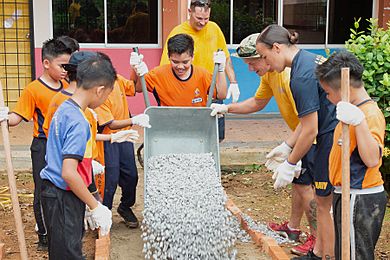Landscaping facts for kids

Landscaping is all about changing how an area of land looks. It can involve many different things, like:
- Adding plants and animals. This is often called gardening, which is the art of growing plants to make a place beautiful.
- Working with natural features like hills, valleys, or bodies of water.
- Considering things like the weather and how light falls on the land.
Landscaping needs some knowledge of horticulture (the science of growing plants) and good design skills. But it's not just about plants! It also includes shaping the land to make it more useful, like building a patio, walkways, or ponds. When the main goal is just to make a place look pretty, it's called Ornamental Landscaping.
Think of your outdoor spaces as extra rooms for your house. Each "room" can have a special purpose. With landscaping, you have lots of choices for materials and what you want to do. People often say that the only limit to outdoor design is your imagination!
Getting Started with Landscaping
Before you start a landscaping project, it's really important to study and observe the land. What works in one part of the world might not work in another. That's why it's often a good idea to ask local experts for help, especially if it's your first time.
Understanding the land is key to successful landscaping. You need to think about many natural things, such as:
- Where the Sun is in the sky throughout the day.
- The shape of the land, like if it's flat or hilly (topography).
- The quality of the soil.
- The direction of the wind.
- The types of plants and animals that naturally live there.
Sometimes, the land isn't quite right for landscaping as it is. You might need to reshape it to make sure water drains away properly. This reshaping is called grading. For big projects like parks or sports fields, you might also need to improve the soil by adding nutrients to help plants grow. This process is called soil amelioration.
When you remove earth from the land, it's called cutting. When you add earth to a slope, it's called filling. Sometimes, grading might involve removing a lot of extra waste, soil, or rocks. Landscapers plan for this during the design stage.
Tools and Techniques
When a landscaping company starts a project, they usually provide a rough design. This shows what they plan to do with the land to get the look you want. Landscaping has become quite modern, and many projects use machines like bulldozers, lawnmowers, and chainsaws.
Different areas have different types of plants that grow well there. If you're planting new grass, the best times to do it are usually in the spring or fall. This helps the grass grow strong and reduces the chance of weeds spreading. Most people agree that using fertilizers, either organic or chemical, helps plants grow better. Some landscapers also like to mix gravel with different sized rocks to add interesting textures to large areas.
See also
 In Spanish: Paisajismo para niños
In Spanish: Paisajismo para niños
- Aquascaping
- Arboriculture
- Ecoscaping
- Horticulture
- Landscape architecture
- Landscape design
- Landscape ecology
- Landscape engineering
- Landscape planning
- Landscape archaeology
- Organic lawn management
- Naturescaping
- Sustainable landscaping
- Terraforming
- Xeriscaping

